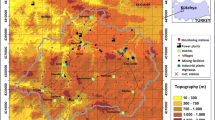Abstract
A hybrid system to compute a fine-resolution spatial distribution of population exposure to SO2 concentration due to mobile and area sources in the tropical city of Villahermosa is described, which consists of an air dispersion model, GIS analysis techniques, and a static exposure model. A methodology to spatially allocate SO2 emissions has been applied, which is adapted to the characteristics of a typical medium-sized city in a developing country. It was estimated that 363.2 tons of SO2 was emitted in the Villahermosa Metropolitan Zone, 21.3 % of which was produced by area sources and 78.7 % by mobile sources. The highest spatially allocated emissions were located in main road intersections, where they reached a maximum value of 39,804 μg s−1, and, in a lesser measure, in the most populated areas of Villahermosa. Performance of the ISCST3 model to simulate hourly SO2 concentrations was similar to that of other studies. The highest SO2 concentrations were located at intersections of main roads in the south-central and southwestern Villahermosa. On the other hand, the lowest SO2 concentrations were found in its north-central district. The highest population exposure to SO2 concentrations was located in areas with high population density like southwestern, south-central, and northeastern Villahermosa. On the other hand, its north-central zone had the lowest exposure due to a low SO2 concentration and low population density.







Similar content being viewed by others
References
Beckx C, Int Panis L, Arentze T, Janssens D, Torfs R (2008) A dynamic activity-based population modelling approach to evaluate exposure to air pollution: methods and application to a Dutch urban area. Environ Impact Assess Rev 29:179–185. doi:10.1016/j.eiar.2008.10.001
Bell LM, Ebisu K, Belanger K (2007) Ambient air pollution and low birth weight in Connecticut and Massachusetts. Environ Health Perspect 115:1118–1124. doi:10.1289/ehp.9759
Coelho MC, Fontes T, Bandeira J, Pereira S, Tchepel O, Dias D, Sá E, Amorim JH, Borrego C (2014) Assessment of potential improvements on regional air quality modelling related with implementation of a detailed methodology for traffic emissions estimation. Sci Total Environ 470–471:127–137. doi:10.1016/j.scitotenv.2013.09.042
EPA (1995) User’s guide for industrial source complex dispersion models. Vol I Users instructions. EPA-454/B-95-003a. U.S. Environmental Protection Agency, Office of Air Quality Planning and Standards, Emissions, Monitoring and Analysis Division. Research Triangle Park. N.C. USA. 390 pp
EPA (1996) Meteorological processor for regulatory models (MPRM). User’s Guide. U.S. Environmental Protection Agency, Office of Air Quality Planning and Standards, Emissions, Monitoring and Analysis Division. Research Triangle Park, N.C. USA. 208 pp.
ERG (2003) Mobile6-Mexico documentation and user’s guide. Eastern Research Group, Sacramento California USA, 26 pp
ERG (2009) Development of Mexico national emission inventory projections for 2008, 2012 and 2030. Eastern Research Group, Sacramento California USA, 57 pp
Hanna SR, Paine R, Heinold D, Kintigh E, Baker D (2007) Uncertainties in air toxics calculated by the dispersion models AERMOD and ISCST3 in the Houston ship channel area. J Appl Meteorol Climatol 46:1372–1382. doi:10.1175/JAM2540.1
INEGI (2014) Estadisticas censales a escalas geoelectorales. Censo de poblacion y vivienda 2010. http://gaia.inegi.org.mx/geoelectoral/viewer.html. Accessed March 23, 2014.
Kinnee EJ, Touma JS, Mason R, Thurman J, Beidler A, Bailey C, Cook R (2004) Allocation of onroad mobile emissions to road segments for air toxics modeling in an urban area. Trans Res Part D Trans Environ 9:139–150. doi:10.1016/j.trd.2003.09.003
Kousa A, Kukkonen J, Karppinen A, Aarnio P, Koskentalo T (2002) A model for evaluating the population exposure to ambient air pollution in an urban area. Atmos Environ 36:2109–2119. doi:10.1016/S1352-2310(02)00228-5
Lakes Environmental Software (2014) AERMOD view. http://www.weblakes.com/products/aermod. Accessed 23 march 2014.
Michalakes J, Dudhia J, Gill D, Klemp J, Skamarock W (1999) Design of a next-generation regional weather research and forecast model. Towards teracomputing. World Scientific, River Edge, USA, pp 117–124
Ossés de Eicker M, Zah R, Triviño R, Hurni H (2008) Spatial accuracy of a simplified disaggregation method for traffic emissions applied in seven mid-sized Chilean cities. Atmos Environ 42:1491–15. doi:10.1016/j.atmosenv.2007.10.079
SEMARNAT (2008) Informe nacional de transferencias y emisiones de contaminantes RETC 2005 (In spanish). Semarnat, Mexico City, 89 pp
SEMARNAT (2014) Programas de Gestión para Mejorar la Calidad del Aire. http://www.semarnat.gob.mx/temas/gestion-ambiental/calidad-del-aire/programas-de-gestion-para-mejorar-la-calidad-del-aire. Accessed 7 July 2014.
SSA (2010) Norma Oficial Mexicana NOM-022-SSA1-2010 Salud ambiental. Criterio para evaluar la calidad del aire ambiente, con respecto al dióxido de azufre (SO2). (In spanish). Diario Oficial. Mexican Government. Mexico City. 8 pp.
Stein AF, Isakov V, Godowitch J, Draxler RR (2007) A hybrid modeling approach to resolve pollutant concentrations in an urban area. Atmos Environ 41:9410–9426. doi:10.1016/j.atmosenv.2007.09.004
Tuia D, Ossés de Eicker M, Zah R, Osses M, Zarate E, Clappier A (2007) Evaluation of a simplified top-down model for the spatial assessment of hot traffic emissions in midsized cities. Atmos Environ 41:3658–3671
Tejeda and Le Bran (2009) Reporte Final Medicion y Adaptacion de variables de actividad vehicular en ciudades tipo de Mexico Villahermosa, Tabasco, Mexico (In spanish). Comision para la Cooperacion Ambiental. 41 pp.
Wilson JG, Kingham S, Pearce J, Sturman AP (2005) A review of intraurban variations in particulate air pollution: implications for epidemiological research. Atmos Environ 39:6444–6462. doi:10.1016/j.atmosenv.2005.07.030
Zou B, Wilson JG, Zhan FB, Zeng YN (2009a) Air pollution exposure assessment methods utilized in epidemiological studies. J Environ Monit 11:475–490. doi:10.1039/b813889c
Zou B, Wilson JG, Zhan FB, Zeng YN (2009b) Spatially differentiated and source-specific population exposure to ambient urban air pollution. Atmos Environ 43:3981–3988. doi:10.1016/j.atmosenv.2009.05.022
Zou B, Zhan FB, Wilson JG, Zeng YN (2010) Performance of AERMOD at different time scales. Simul Model Pract Theory 18:612–623. doi:10.1016/j.simpat.2010.01.005
Acknowledgments
This study was supported by the PFICA research program of the Juarez Autonomous University of Tabasco. We want to thank Ebelia del Angel Meraz and Gaspar Lopez Ocaña for their collaboration. We would like to thank the anonymous reviewers that help us to improve greatly this paper.
Author information
Authors and Affiliations
Corresponding author
Rights and permissions
About this article
Cite this article
Valdés Manzanilla, A., de la Cruz Uc, X. Spatial distribution of SO2 concentration and population exposure in the tropical city of Villahermosa, Mexico. Air Qual Atmos Health 8, 321–329 (2015). https://doi.org/10.1007/s11869-014-0273-8
Received:
Accepted:
Published:
Issue Date:
DOI: https://doi.org/10.1007/s11869-014-0273-8




